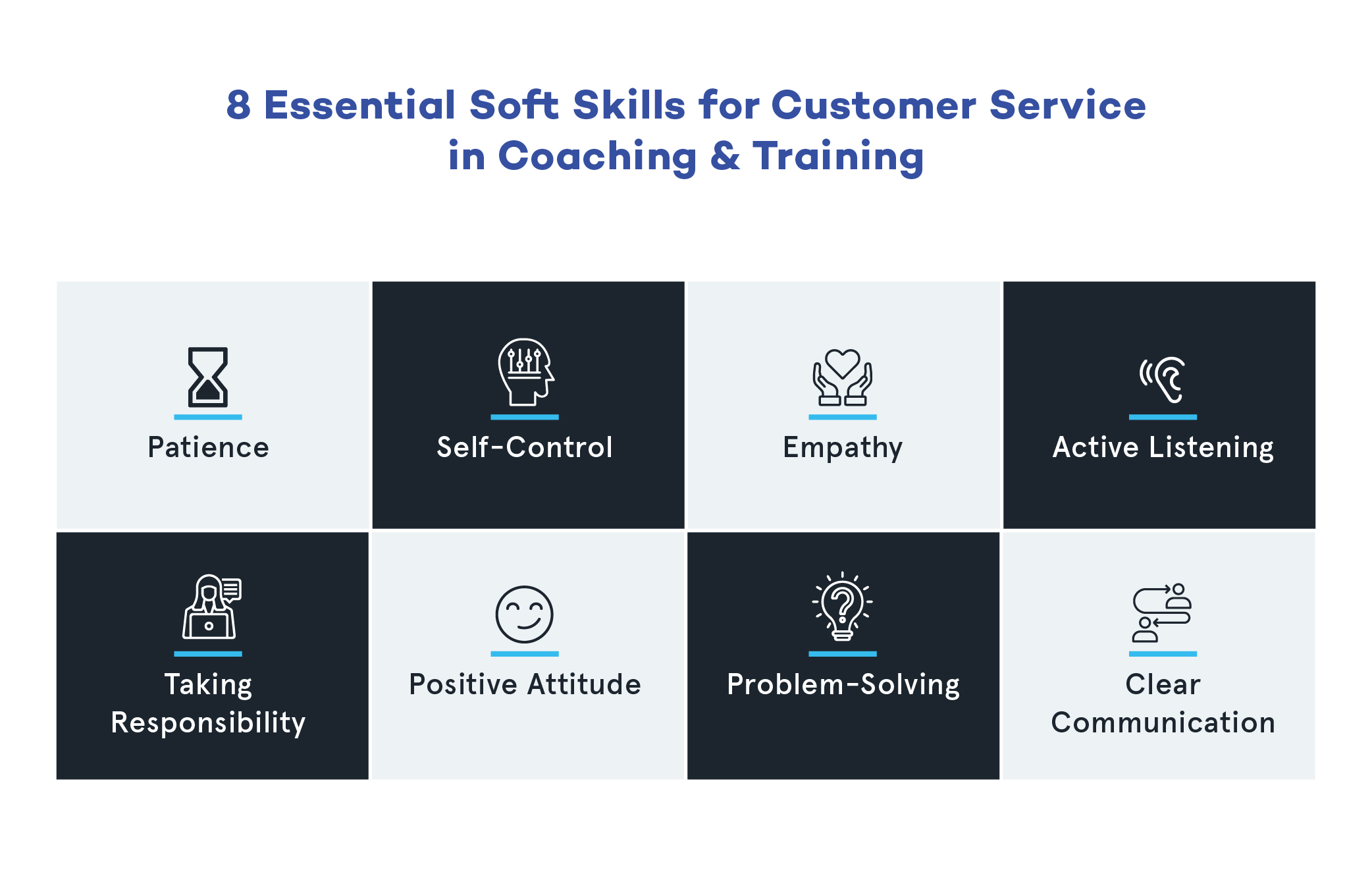Customer service is a business element we often relate to large companies.
What comes to mind when you think of customer service?
Do you imagine a large room with dozens of people in cubicles answering phone calls from frustrated and confused customers?
Do you think of a recent series of email exchanges you had with an agent named Patricia after you received the wrong item in the mail?
Or, do you think of going back to the store where you bought that new shirt that doesn’t fit to talk to a customer service representative at her desk?
Customer service is all these things, and much more. Many of the go-to ideas about customer service bring to mind experiences with big companies with a prominent sales force. However, customer service is an essential component of any functioning business, both big and small, that offer products and services or a mix of both.
Have you given much thought to the customer service component of your coaching or training business? This article will help you critically analyze your current customer (client) service offerings, and it will give you ideas about how to improve the customer service experience your brand offers.
What Is Customer Service?
Customer service is the term given to the one-on-one interaction between a customer, consumer, or client who has provided a company money in exchange for a good or service and the company selling it.
In most coaching and training business models, the customer is actually a client or a patient, since they pay regular fees for a longer-term interaction with you or your brand representatives.
In some cases, however, if you offer a product or short-term digital service like a meal plan, a guide, or a fitness plan, you might have customers as well.
The element of your business activities where you interact directly with the customers and clients is your business’s customer service.
The Importance of Customer Service for Your Training and Coaching Business
Customer service has the potential to have a significant impact on your clients’ perception of your company and the services and products you offer. Even if you have a groundbreaking fitness program or weight-loss program, if most of your coaching clients have negative customer service experiences, they will most likely have a negative view of your fitness and coaching brand.
Positive customer service experiences, however, are critical to your business success. When your clients and customers feel like their needs are met, their questions are answered, and, ultimately, if they feel like you care about them, they will have a favorable view of your fitness and coaching brand.
When you are successful at providing excellent customer service to your coaching clients or patients, you are ensuring brand loyalty, client satisfaction, and client longevity.
As your business begins to grow, those elements are essential since, at the end of the day, they will help secure a steady income for your business.

The Essential Business Course for Health and Wellness Entrepreneurs
Gain the skills needed to build and run a thriving, lucrative health and wellness business.
How Does Customer Service Look in a Training and Coaching Business
If your image of customer service looks like some of the scenarios mentioned at the beginning of this article, it might be challenging to imagine how customer service fits into your small-but-growing fitness and coaching brand.
Some customer service activities in health and wellness coaching and fitness businesses include:
- Answering emails from clients
- Talking to clients about their concerns and answering questions one-on-one
- Texting with clients (often a nonstop job)
- Responding to comments and questions on your social media posts and social media direct messages. Note: Sometimes, people you reply to aren’t customers yet. Still, if you respond similarly to clients and non-clients on your social media accounts, it is one example of how sales and customer service can meld together.
- Answering client phone calls and voice mail
- Scheduling regular client meetings (in-person and on the phone)
So, when you answer your client’s text at 10 pm on a Saturday about how much wine they can drink on their meal plan, that is customer service (of course, we aren’t encouraging this—setting boundaries is healthy and essential to keep your business sustainable).
In short, every time you make one-on-one contact with your client, you are providing customer service. In other words, training and coaching can even be viewed as a business built on customer service.
Thinking of Outsourcing Customer Service?
If the volume of clients becomes too demanding to dedicate the time necessary to some of the more administrative aspects of your business, you might want to consider outsourcing some of the duties of your brand.
This can be a difficult decision for solopreneur coaches to make, as they have learned the ins and outs of every minute detail of their business from day one. There might be some tension as you wonder whether someone else will give the same time and dedication as you do to different administrative, sales, and marketing aspects of your business.
However, you might find that hiring an agency or a freelancer to take on some of the customer service and sales aspects of your business will give you more time to focus on the wellbeing of your clients and plan for business growth.
We will be going into further detail about the dynamic of outsourcing certain services as a coach in a later article, so stay tuned.
Coaching Yourself as a Customer Service Agent
If you Google “coaching + customer service,” you won’t find many articles on how to provide customer service as a health and wellness coach. Instead, you’ll find dozens of articles about how to coach or train people to be active customer service agents.
This is no coincidence. The art of coaching and customer service are intimately related.
{% module “module_159118115540596″ path=”/AFPA 2018/Custom Modules/Section/AFPA – Highlight box”, label=”AFPA – Highlight box” %}
Let us look at these one by one in the context of customer service:
Goal-Setting
As soon as you get a message from a client that asks you a direct question or comment, you should have a clear goal in mind directed at client satisfaction. For example, if a client asks you why you’ve increased their exercise reps this week, a detailed but easy-to-understand answer about building strength and resistance will leave them satisfied. If they ask about the alternative nutrition coaching plans you offer, providing those plans will keep them satisfied, and your goal will have been achieved.
Listening
Paying close attention to your client’s individual concerns will help you select and deliver the information that is most relevant to them. If a client receives a generic response, they will not feel like you are listening to them and could lose interest.
Empathizing
Always try to put yourself in your client’s shoes. If they’ve had a negative experience with one of the services or products you offer, let them know you are genuinely sorry. Then, ask yourself, if you were in the same position, what would you need to feel good about the service again?
Behavior and Attitude Change
This can be applied in two contexts. If a client communicates with you because they aren’t satisfied with the service they’ve acquired from you, then you want to provide them with the information and insight they need to change their opinion and negative attitude.
Checking-In
Regularly, you check with your client to make sure they understand the plan for the week, have any questions, and whether the goal has been reached. Similarly, you want to check-in with them from a customer service perspective to make sure their questions are answered and make sure they are satisfied with the service you’ve provided.
While email and messaging is a great place to do this, verbal in-person discussions or video calls are equally important. When you see the person, you can pick up nonverbal cues like body language and facial expressions to get a better sense of what your client is feeling. If they aren’t satisfied, it allows you to act immediately and continue to work to solve any concerns or issues they may have.
Customer Service Roles You Can Take On for Great Client Experience
In many cases, health and wellness coaches take on multiple roles throughout the week. When you aren’t a marketer, content writer, salesperson, CEO, and (finally) coach, you find the time to tend to your clients’ and customers’ worries, concerns, suggestions, comments, and, yes, even complaints *gulp*.
You might even take on several customer service activities without realizing that is what you are doing.
As you read through this list, you’ll find that there is a lot of overlap between the customer service roles we mention here and several skills that are central as a coach. This isn’t a coincidence. Coaching is 100 percent people-centered. Even when they have automated services, almost all coaches have a one-on-one aspect to their coaching business as part of the standard services they offer. While you think of it as “just doing your job,” you are simultaneously taking on some customer service roles.
Here, we describe different customer service roles that you can take on to improve your clients’ experience with your brand. You may find that you already have some of the roles well-established within your brand, while others you might have to build from the ground up within your business.
The Teacher
One of the pillars of coaching success is teaching your clients new skills, valuable knowledge that will contribute to their health, how to exercise at home, how to cope with the mental stressors of everyday life while staying on track, and much more.
However, there is an essential difference between telling your client how to do something and teaching them how to do it. From a customer service perspective, educating your clients means that they will likely only reach out to you once for an issue they keep stumbling on. That’s a time investment worth making.
The critical difference is focusing the explanation on the logic behind problem-solving and decision-making.
For example, if your client reports back pain after a particular exercise set you’ve given them to do on their own time at home, you would ask them about their history of injuries (they say they don’t have any). Then you ask them to show you how they perform the different exercises. As you observe attentively, you notice the problem. You see that when they lift weights, they have poor posture.
At that moment, you can teach your client how to make the most out of the exercise without experiencing pain. To do this, you’ll want to explain the importance of posture during weight lifting and describe how their weight lifting is putting a strain on their back. Ask them to feel the difference and repeat the exercise the correct way. By being a teacher, your client will likely only ask you about this issue once.
Detective
Optimization is a process that makes your service offerings more streamlined, easier to use, and “bugless.” If you have a digital component to your business (online exercise or recipe channel, an app, a website), optimization becomes even more critical.
First, look at digital data. Depending on the platforms you use, digital data may be able to tell you a wide variety of client behavior, including at what point during their visit do they exit your website, when they log off after putting things in their online cart without purchasing them, and which pages receive the most and least traffic. By examining this data and mimicking client behavior, you may be able to find website bugs people aren’t reporting.
Second, look at direct messages from clients who are reporting bugs, issues, typos, broken links, or even confusing instructions. This input takes less detective work in the sense that they are telling you about their experience. You (and your team) just need to go back and find out why the issue occurred.
Helper
“The helper” is arguably the most familiar customer service role; most people who reach out to a business’s customer service and support channels need help overcoming a particular hurdle.
If you are quickly able to provide a solution to the problem they are having or provide them with the support they need, you are gaining their trust.
Note that patience and self-control are some of the most critical soft skills for you to have when providing help to your clients. Some people have more issues with technology, don’t read instructions carefully, or don’t have much patience themselves. You may find this annoying. However, you must keep your cool, speak to them respectfully, and be as helpful as possible when providing them with a solution. Every opportunity for one-on-one interaction with your clients is an opportunity to ensure customer loyalty.
Do you feel like you need a reminder for the right attitude to bring to the table when you are communicating with clients? Set the infographic below as a desktop background or print it out and put it in a place that is visible to you when you respond to clients.

Therapist
As you know by now, there is a strong psychological component to training and coaching. Understanding client frustrations and emotions that keep them from making decisions that put them on the road to wellness, and, ultimately, achieving behavior change is a central component of successful coaching.
That skill is equally applicable to providing effective customer service. You will get calls and messages from angry and frustrated clients. Their attitude may have something to do with a mistake you have made, but often, it has to do with a series of other frustrations they are experiencing, and a small issue with logging into your site might have just been the last straw.
Empathy and accepting responsibility are critical soft skills needed to become a better therapist in your customer service strategy. Understanding where the client is coming from and how their experience with your business factored into their frustrations, and accepting responsibility are just some of the skills you need to put into practice.
Salesperson
As a coach, you likely offer different types of services and perhaps even products. When clients get in touch with you, you might be able to spot the customers that could benefit from different tiers of your service or product offerings.
Different sales tactics include upselling, downselling, and cross-selling, and there is an art to each strategy. Some health and wellness coaches, who naturally want to help people, don’t like the aspect of selling their services because they feel like they are being ingenuine somehow.
Here, you can find a great article on how to upsell to increase customer happiness, retention, and increase your revenue.
Main Takeaways
Customer service isn’t just for large businesses with thousands of customers who need product exchanges and technical troubleshooting.
By nature, most fitness and health and wellness coaching businesses have one-on-one relationships with their clients at their core. This makes customer service closely entwined with the everyday activities of health and wellness coaches. As you are answering questions about a new exercise routine or meal plan, you are not only being a coach, you are being a customer service agent.
When you communicate with your clients to acknowledge comments or suggestions, solve issues, or teach them how to use one of your service offerings, there are several customer service roles and soft skills that can increase client satisfaction. In this article, we’ve mentioned five key customer service roles for your training or coaching business, including that of the teacher, the helper, the optimization detective, the salesperson, and the therapist.
Take a moment this week to identify which roles you are strongest at and which you can improve. When your clients are satisfied, not only do you lock in their loyalty, you also increase client happiness, retention, and, ultimately, increase your revenue.

The Essential Business Course for Health and Wellness Entrepreneurs
Gain the skills needed to build and run a thriving, lucrative health and wellness business.



